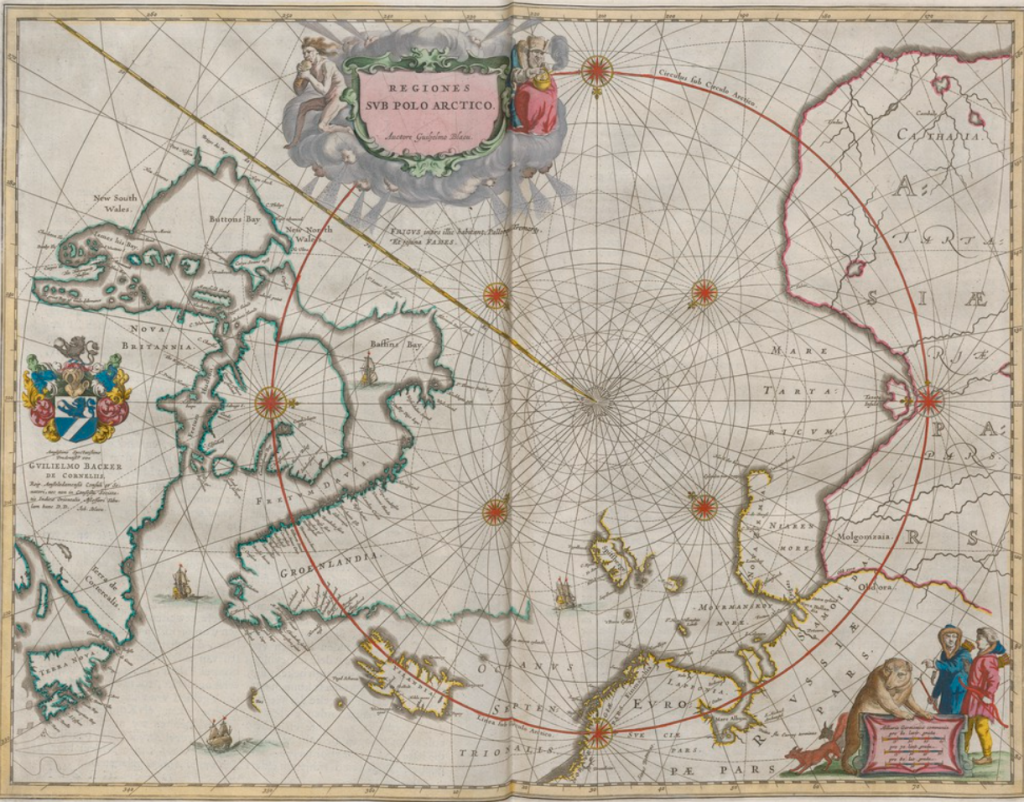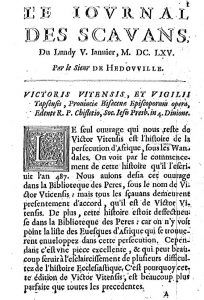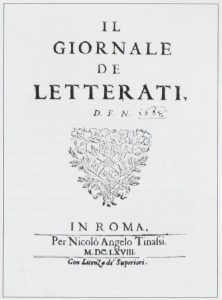—Books, letters and the first scientific journals were the material media for the circulation of knowledge among the European and colonial elite participating in the Republic of Letters.—
Although not immediately and, of course, without replacing or making the culture of the manuscript obsolete, the appearance of books printed with movable type in the mid-fifteenth century marked a remarkable transformation in the system of the circulation and communication of knowledge of written culture. In the medium and long term, the printing press changed the relationship between text and image, the reliability given to mechanical reproduction of both and, ultimately, allowed the knowledge of which these instruments were the medium to be made increasingly available to wider audiences and in an identical form.

Grooten Atlas by Blaeu (1664). Universiteit Utecht.
Of course, it was not just a question of exchanging written information, whether printed or handwritten. It was about so much more. In the first place, because in books and in letters, images travelled in addition to the written word. Secondly, because, along with letters and books, many other things travelled through a network that reached beyond Europe, to both sides of the Atlantic, the Indian Ocean and the Pacific: botanical, zoological or geological materials of all kinds; results of astronomical, geographical or meteorological observations; anatomical figures, models and preparations; instruments and apparatus indispensable for all these observations and for experiments in chemistry or physics; and a long list of materials that were the best media for new knowledge, even if these were not expressed in a written text or took time to circulate in printed letters.

First page of the first issue of the Journal des Sçavans (5 January 1665). Bibliothèque Nationale de France.
Thus, it would be a mistake to consider handwritten and printed matter separately, as if they were located in different cultures or in different knowledge systems. We only have to consider how the printed texts and manuscripts were continuously related to each other and related to the other objects, spaces and practices that shaped the scientific culture of that time. The most obvious and original link in this relationship is the exchange of letters. The letter was the sine qua non for all these materials – including books – to circulate and communicate the knowledge they carried. Writing letters necessarily implied sending them, reading them and answering them, as writing books also involved publishing them and exchanging them with other authors. In reality, the two things were often intertwined: letters were written that, time after time, dealt with books (to comment on, request, criticise and gift them) and books were published that dealt with how to write letters or that, in many cases, were a compendium of letters. The publication of collections of letters, beginning with the Renaissance humanists, now acquired a special significance and undoubted editorial success in subjects such as medical consultations, mathematical or astronomical discussions or philosophical debates. A scholar at his desk putting pen to paper to answer a colleague could not help but think that perhaps he was no longer writing only for his correspondent, but for a much larger potential audience, for the letter may end up being published in print. The ‘philosophical letter’, as it came to be called, was a privileged vehicle of communication among experts, scholars or collectors interested in the secrets of nature.

Allegorical image with the image of the three founding theoreticians of the Royal Society under the protection of King Charles II on the back cover of Thomas Sprat’s history (1667). Wikimedia.
The then self-defined ‘Republic of Letters’ imposed different ways of creating a cultural environment that no longer depended so much on the three spheres in which scientific culture had hitherto moved: the court, the university and the clergy. Various authors, in different parts of Europe, started discussing with extraordinary speed the appearance of new works through letters and sending books. Above confessional, dynastic or territorial loyalties, they all agreed on a common space in which knowledge and discussion on it should reign unhindered. The circumstances, motives and meanings of the publication of scientific books, the very geography of their edition and circulation, the regard and impact on readers were transformed in the second half of the seventeenth century. Naturally, this image of a virtual (but not digital) European space exclusively dedicated to the cultivation of knowledge and driven by the altruism of cooperation has been considerably idealised. However, every representation ends up having effects on the reality it tries to represent.
Scientific culture, then as it is now, was the result of a very diverse set of practices. Science is not an imaginary entity in a void: it is material culture. This fact was more evident than ever in the period analysed and the scientific book reflected this in an extraordinarily effective way. It is sufficient to mention some examples such as Les Fortifications (1628) by Antoine Deville (1596-1657), the Traité de la chymie (1676) by Christophe Glasser (1615-1672 ca.), the Adenographia (1696) by Anton Nuck (1650-1692) or the medical surgical work (1701) of Steven Blankaart (1650-1702), among others, to clearly see the materiality of that culture, of all the accompanying images, instruments and objects that science implies. The new experimental philosophy, the epistemological and methodological considerations of Baconian or Cartesian roots which went with it, the defence of the freedom to philosophise, of the human drive towards ‘the inquisition of truth’ as the objective of the new philosopher born in the Republic of Letters: all this was consolidated and triumphed because underneath this there was a solid transformation of cultural practices around the written text and, above all, around the printed book. It may be, of course, that the so-called ‘printing revolution’, which Elizabeth Eisenstein and her opponents discussed forty years ago, was not such a revolution at the very moment of the emergence of this technical breakthrough, at the end of the fifteenth century. However, there is no doubt that, seen from the perspective of two centuries later, the printing press ended up producing a new cultural order. Nevertheless, it must be emphasised that, within this, manuscripts continued to carry considerable weight: from prescriptions to laboratory notebooks, to travel journals or drawings carried out in the field or with the microscope.

Front cover of Il Giornale de Letterati, published in Rome (1668). Wikimedia.
The emergence of scientific journals was another important novelty in the transformations in the world of knowledge caused by the printed book. This is not a contradictory statement, despite perhaps seeming so at first sight. First because, from the material point of view, those first scientific journals were formally books. Then because, in essence, the scientific journals of that time were about books. The founders of the first of these, the Journal des Sçavants, said no less when they presented the first issue to the public, which appeared in 1665: ‘The aim of this journal is to make known what is happening in the Republic of Letters and it will consist first of all of a precise catalogue of the main books that are printed in Europe’. The Journal des Sçavants in Paris, the Philosophical Transactions in London (also begun in 1665), the Giornale dei Letterati in Rome (inaugurated in 1668), the Acta Eruditorum in Leipzig (which began to be published in 1682) were born, above all, as book journals, that is, as vehicles of information about what had been published anywhere in that theoretically borderless geography that was the Republic of Letters.
The map of that geography thus covered a network of cities located over the length and breadth of the continent, its adjacent islands and even reached enclaves in other continents dominated colonially by their respective European metropolis. However, within the inside layout of these cities, the scientific book was involved in very different public, semi-public and private areas. In this urban landscape, new spaces arose in the spaces where book, maps and scientific journals were circulated: aristocratic salons, the rooms of academies and societies, cabinets of curiosities, gardens and theatres, to which chocolate shops, tea rooms and cafés would soon be added. They were places that, as can be seen in other sections of Knowledge in Action, made up authentic spaces of science.
José Pardo Tomás
IMF-CSIC
How to cite this paper:
Pardo Tomás, José. Knowledge in circulation: letters, books and journals. Sabers en acció, 2020-12-07. https://sabersenaccio.iec.cat/en/knowledge-in-circulation-letters-books-and-journals/.
Find out more
You can find further information with the bibliography and available resources.
Recommended reading
Bethencourt, Francisco; Egmond, Florike (eds.). Correspondence and Cultural Exchange in Europe, 1400-1700. Cambridge: Cambridge University Press, 2007.
Ogilvie, Brian. Correspondence Networks. In: Bernard Lightman, ed. A Companion to the History of Science, Oxford: Blackwell; 2016: 358-371.
Johns, Adrian. The Nature of the Book: Print and Knowledge in the Making. Chicago: The University of Chicago Press; 1998.
Studies
Bots, Hans; Waquet, François (eds.). Commercium litterarium, la communication dans la République des Lettres 1600-1750, Amsterdam: APA- Holland University Press; 1994.
Briggs, Asa; Burke, Peter. De Gutenberg a Internet. Una historia social de los medios de comunicación. Madrid: Taurus; 2002.
Del Lungo Camiciotti, Gabriella. Letters and Letter Writing in Early Modern Culture: An Introduction, Journal of Early Modern Studies, 3, 2014:17-35.
Eisenstein, Elizabeth L. The Printing Press as an Agent of Change: Communications and Cultural Transformations in Early-Modern Europe. Cambridge: Cambridge University Press, 1997.
Hunter, Michael. Editing Early Modern Scientific Correspondence: The Way Forward. Isis 107 (2), 2016: 365-372.
Mayhew, R. Mapping Science’s Imagined Community: Geography as a Republic of Letters, 1600-1800, British Journal of the History of Science, 38 (1), 2005: 73-92.
Steinke, Hubert. Why, What and How? Editing Early Modern Scientific Letters in the 21st Century. Gesnerus, 61, 2004: 282-295.
Warner, Michael. The Letters of the Republic: Publication and the Public Sphere in Eighteenth-Century America. Cambridge, Mass.: Harvard University Press; 1990.



